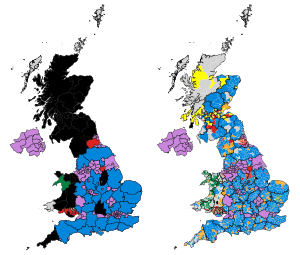United Kingdom local elections, 2018
|
|
|||||||||||||||||||||||||||||||||||||
|---|---|---|---|---|---|---|---|---|---|---|---|---|---|---|---|---|---|---|---|---|---|---|---|---|---|---|---|---|---|---|---|---|---|---|---|---|---|
|
|||||||||||||||||||||||||||||||||||||
|
34 English councils All 32 Scottish councils All 22 Welsh councils 8 directly elected mayors in England |
|||||||||||||||||||||||||||||||||||||
|
|||||||||||||||||||||||||||||||||||||

Map showing council control (left) and largest party by ward (right) following the election.
Majority of independent councillors No overall control No election on 4 May 2017 |
|||||||||||||||||||||||||||||||||||||
Conservative Labour Scottish National Party
Majority of independent councillors No overall control No election on 4 May 2017
The 2018 United Kingdom local elections will be held in May 2018. Local elections will be held within England, with elections to all 32 London boroughs, 35 metropolitan boroughs, 74 district/borough councils and 20 unitary authorities. There will also be elections for the Mayoralties of Hackney, Lewisham, Newham, Tower Hamlets and Watford.
All registered electors (British, Irish, Commonwealth and European Union citizens) who are aged 18 or over (or aged 16 or over in Scotland) on polling day will be entitled to vote in the local elections. A person who has two homes (such as a university student having a term-time address and living at home during holidays) can register to vote at both addresses as long as they are not in the same electoral area, and can vote in the local elections for the two different local councils.
...
Wikipedia






